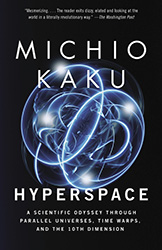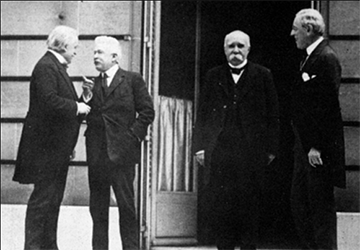VIEWS AND OPINIONS

Credit: Reuters photo RTX3ZOY by Andy Clark
A frozen lake at dusk near Banff, Alberta
May Peace Be Upon Us
by Garrett Lawless
For more information on accessing this file, please visit our help page.
Were aliens to visit us, would there be cause for alarm? In his book Hyperspace, Machio Kaku argues that any life form capable of intergalactic travel could only come in peace. His reasoning focuses on a nomenclature that he applies to the nature and quantity of energy that a civilization is able to harness. Levels 0 (consumed food) and 1 (fire) permit the possibility of a war-promoting culture thriving because using energies at these levels for the purposes of war will not necessarily extinct a species. Level 2 however, represents the harnessing of nuclear power, and so introduces the possibility of total auto-annihilation. This developmental level is a kind of ‘moment-of-truth’ for a species; because any civilization that manages to reach this stage in the mastering of nature will either kill itself, or else embrace peace. As it is predicted that any kind of intergalactic travel will require at least level 3 energy control (the equivalent of mining small stars such as our sun), should any extra-terrestrial alien life ever visit us, we will have no reason to fear them, for to achieve what they have achieved and still exist, they must have become a peaceful race.1

Credit: Random House Canada
Cover of Hyperspace by Michio Kaku
Stephen Hawking disagrees, and he looks to our own species as proof. When considering how within human history, superior civilizations have treated less advanced ones following initial contact, it is easy to see his point. The European discovery of North America did not result in positive effects for the indigenous populations. However, there is an important point that Hawking misses when presenting his fears. While European civilization was much more technologically advanced than the tribes of North and South America, they remained, in the vernacular of Kaku, a level 1 species. Considering the current cultural advances that level 2 civilizations are making today, alien prospects are much more promising; colonialism is dead, slavery is dying, percentages of populations that perish in wars is dropping, crime and violence are down, civil liberties are up, and rapid advances in education, science, and technology are globalizing.2 In this way, when Western military organizations consider the conflicts that they may face in the future, and the challenges for which they should then be preparing, it will be valuable to shift focus away from the conduct of classical war and move it instead towards more tangential defence issues, such as economic development and local governance. In the nuclear age, classical war between major powers is either dead, or we are doomed. Encouragingly, in an age of economic globalization, war is also prohibitively bad for business, and the new requirement for a stable and lasting peace is the provision to all humans of a future worth living for.
The first serious warning that human civilization needed to embrace peace or face extinction pre-dates the nuclear age, although only marginally. Jan Bloch was a Polish banker and wrote an extensive economic analysis of classical war within the industrial age that existed at the turn of the last century. Given the capabilities of that age, Bloch predicted bankruptcy and revolution as the new spoils for any advanced nation that went to war against another similarly advanced nation.3 A decade-and-a-half later, Bloch’s warning was ignored and the First World War erupted, proving unquestioningly that the spoils of war had changed just as Bloch had predicted. However, the mistakes of the Great War were not over at its conclusion The immodest impositions placed upon Germany within the terms of the Treaty of Versailles set the world upon the path to the Second World War, and ultimately, towards the expedited discovery of nuclear power and weapons.4

Credit: AKG 7EN-11-012133 (IAM/akg)
Paris Peace Conference, 1919, and a meeting between (left-to-right) Prime Ministers Lloyd George (GB), Orlando (IT), Clemenceau (FR), and President Woodrow Wilson (US).
The good news is that the Second World War represents the last time that major powers have directly gone to war against one another. Extrapolating from Bloch’s economic analysis of classical war in his age, and adapting it to the modern age, the advanced nations of the world appear to have recognized that the new fruits of war are no longer just bankruptcy, but extinction. As a result, war has become limited to smaller clashes where major powers, if they are even involved directly, do not employ anything near the limits of their combative capability. Today, when war between major powers is considered hypothetically, such as a war between China and the U.S., it is nearly always spoken of in terms of a looming Cold War; as if anything else is simply inconceivable.5 So what of the remaining clashes among smaller powers, or where a major power engages a smaller power? Are these to remain the new war of the future, or is there hope that these too may become inconceivable?
In 1976, Richard Dawkins introduced the idea of the meme. In the same way that the gene represents the unit of transmission for human biology; the meme, which is defined as any idea or behaviour that spreads within a culture, represents the unit of transmission for our cultural evolution.6 Similarly, war can be understood to be a cultural contagion that acts as a meme. When one points to discrete causes of war, such as resource scarcity, inequality, or sociopathic leadership, the underlying root of the problem is not understood. Taken existentially, war really occurs when a culture accepts war, and is avoided by cultural rejection.7 These other tangential factors may certainly be strong attributes of particular wars, but the decisive factor in the decision to go to war remains the presence of a militaristic culture, where a population either glorifies war or even just accepts it. Sadly, history shows that national leaders often love war, and that even when they do not, because they otherwise mistakenly feel that war is an inevitable part of human nature, they invariably fail in their attempts to prevent war.8

Credit: Reuters photo RTR306L5 by Chris Keane
Richard Dawkins
So, is war an inescapable facet of human existence? If it is, then now that our species has reached Kaku’s second level of energy stewardship, we are surely doomed. However, if war is simply a cultural meme, we may take hope in our understanding of how culture develops, that war can become a part of our inglorious past in the same manner as so many other horrors that we no longer embrace. The provision of some genuine understanding of cultural evolution is obviously beyond the scope of this short article. However, consider that humans generally adopt their attitudes towards experiences in life from example responses that they have witnessed in others previously,9 and that the way that these external experiences are passed to other members within a culture, so modifying their emotional and intellectual responses to stimuli, is through memes.10 The possibility and efficiency through which these memes may travel among and between humans is based entirely upon the scope and power of the communicative vehicles existent within society. Thus, in an age of globalization and rapid technological advance, the capacity to transmit a peace meme ubiquitously is a very real possibility, and this is grounds for optimism. For this meme to take root and spread efficiently, it will be helped greatly if it can be linked to another cultural meme already accepted and believed in within global populations. So it is, that within the increasingly materialistic world that we presently find ourselves within, perhaps the most promising meme to begin with is the idea that war is, quite simply, bad for business.
A capitalist, free-market economy must enjoy peaceful cooperation if it is to thrive. Divisions of labour between states obviously cannot function effectively when war exists between these same states, and so war will be economically inhibited between states that are trade partners.11 The corollary to this assertion is that no-war scenarios are not necessarily good for business either. Certainly, the risk premiums associated with as-of-yet unrealized war between posturing states can certainly have detrimental effects on investment and trade.12 Also, it remains uncontestable that Keynesian disciples may rightly assert that government spending for war stimulates the national economy, and with ample historical references. However, more recent experience shows that today, even short wars against weak states can prove exceptionally costly, and if these wars persist the economic effects can be devastating.13 Indeed, the U.S.’s recent war in Iraq risked and won politically unacceptable casualty rates, deep economic recession, and deep international unpopularity and resentment that have directly affected trade relationships.14
The idea that trade partners are unlikely to go to war with one another is not unusual. Most often, this idea is expanded to encompass the notion that democratic nations will not go to war with each other; but it is a mistake to presume that simple democracy leads to peace. Indeed, as first pointed out by John Stuart Mill, within politically heterogeneous societies, democracy risks violence as cultural sub-groups will compete for political favour, particularly if political systems are perceived to be weak or corrupt.15 Rather, the political system that appears to hold the most promise for peace is democratic liberalism. Within this construct, free trade and the free mobility of labour mean that one’s standard of living is de-linked from territorial expansion.16 This of key importance, for it is only when foreign intervention holds the promise of economic advantage that war may be profitable and a national culture may become bellicose. But as globalization expands and liberalism grows in influence, the opportunity to find such advantages are diminishing17 and with it, so are the reasons to go to war.
Whatever disadvantages war may impose upon modern economies, it cannot be forgotten that the reason for the relative peace that exists among the world’s advanced powers is due in part to the existential threat associated with nuclear war. Were all of the world’s nuclear capabilities removed, it is possible that classical war would still be avoided on account of Jan Bloch’s economic warnings about non-nuclear industrial war, but nuclear auto-annihilation remains the more formidable prohibitive threat. Thus, one idea that is gaining some strength among some defence planners seeking to reduce the chances of future wars is to encourage and assist certain politically stable powers to become nuclear powers themselves. For example, were the U.S. to permit certain Asian democracies to arm themselves with nuclear weapons, the U.S. would then enable these nations to assure their own security from the threat of China, rather than have the U.S. accept responsibility for their defence.18 Such action would save the U.S. significant treasure, particularly if China becomes more aggressive in the region; but more importantly, a nuclear Taiwan would be a much more effective deterrent against Chinese military aggression than the U.S. promise of protection.
Sanctioned nuclear proliferation of this sort would effectively amount to an ‘all-in’ bet that humanity will be able to leave its warring ways behind and embrace peace. Understandably, the idea does strike fear in the hearts of many defence planners, and it is this fear that impedes the meme’s progress. If the bet loses, the consequences are simply too great; but what gets missed in this line of reasoning is the fact that the bet has already been made. Significant nuclear weapons are already held by the U.S., China, Russia, North Korea, Israel, Britain, France, India and Pakistan. While increasing the number of nations with nuclear capabilities can be argued to increase the statistical probability of nuclear war, political actions to prevent proliferation appear too often to be based upon weakly-veiled xenophobia rather than mathematics.19
So, what will war in the near future look like? Neglecting the unimaginable, wars will probably look much as they do today. Until the world as a whole is brought into productive trade relationships within a liberal democratic construct, wealthy states will continue to intervene in poor states, and then attempt to help those states develop into more advanced states with socio-political structures to enable lasting peace through effective trade.20 While it is a relatively easy matter for an advanced state to defeat a weak state militarily, counter-insurgency operations will likely become increasingly common. More importantly, the ability of military planners to become familiar with issues such as economic development and local governance, and so to include these issues as primary foci within overall operational planning will also become of key importance. As war becomes confined to areas where populations simply feel that their future is not worth living for, the fulcrum of peace will become the provision of hope.21 Specifically, nations at risk of war need to be brought up to a political and economic level such that war becomes counterproductive, and ultimately, this will mean establishing and nurturing a local economy fortified by trade.
No poor country has ever become wealthy without trade, but trade alone is not enough.22 Additionally, good governance is required because a burgeoning economy must be tied to governance policies that lift people out of poverty and distribute benefits equitably across and within the developing nation. This means the construction of roads, ports, electrical power facilities, and other such national infrastructure projects. In cases where there has been no military intervention working as a catalyst to these measures, simple aid-for-trade partnerships hold great promise,23 but in cases where there has been military action, it will be of primary importance that the eventual need for these structures is recognized and understood from the outset of operations planning. For the transformation to be effective, the operation will need to be a holistic one that encompasses battling insurgency and corruption while concurrently establishing and maintaining a political climate where construction can begin on infrastructure projects aimed at facilitating future trade.24
So, is it really possible that classical war is over? This is an exciting proposition, and hopefully, it is also one that will inspire great human enterprise towards peaceful pursuits; but before true peace settles on our planet, humanity will continue for some time to struggle with conflicts erupting within weaker states. In these states, success should be defined as the provision of hope through good governance, effective trade, and distributive wealth. If these can be accomplished, then the peace meme may flourish globally, and perhaps war will finally leave us for good. This is an ambitious but not impossible objective. Achieving it will mean that our militaries will need to become adept at operations that assist and enable economic development and good governance. Such focus will likely mean that these new skills will be developed at the expense of degradation in more core fighting capabilities, but we must believe that the requirements for such capabilities are not what they used to be. Major classical war cannot be allowed to happen ever again. Alas, if it does, highly skilled fighters and powerfully equipped war forces will not make any difference to the outcome whatsoever. The bet on peace has already been made. In two centuries time, humanity will either be capable of intergalactic travel, or it will be no more.
Major Garrett Lawless is an Air Mobility pilot in the Royal Canadian Air Force, and is currently working as a Military Assistant to the Minister of National Defence. He has an undergraduate degree in Electrical Engineering and a Master of Arts degree in Security and Defence Management and Policy from the Royal Military College of Canada, as well as a Master of Defence Studies from the Canadian Forces College.

Credit: Courtesy of Heather Bashow
Dawn fog shepherd
Notes
- Michio Kaku. 1994. Hyperspace: A Scientific Odyssey through Parallel Universes, Time Warps and the 10th Dimension. (Oxford, UK: Oxford University Press, 1994), p. 165.
- Michael Shermer. “The Myth of Evil Aliens: Why Stephen Hawking is wrong about the Dangers of Extraterrestrial Intelligences,” in Scientific American 153 (6), 2011, pp. 70-76.
- Crawford Kilian. “The Forgotten Lesson of Jan Bloch: His 19th Century Analysis Proved Big Wars Lead to Bankruptcy and Revolt, but Canada’s Little Modern War has Serious Costs, Too,” in The Tyee, 2010.
- John Horgan. The End of War. (New York, NY: McSweeny’s Publishing, 2012).
- Elizabeth Dickenson. “The Future of War.” Foreign Policy 133 (3), 2011, pp. 177-185.
- Richard Dawkins. The Selfish Gene. (Oxford, UK: Oxford University Press, 1976.)
- Horgan. 2012.
- John G. Stoessinger. Why Nations Go to War. 11th Edition. (Boston, MA: Wadsworth Learning, 2011).
- G. W. F. Hegel. Phenomenology of Spirit. Translated by A.V. Miller. (Delhi: Motilal Banarsidass Publishers Private Limited, 1998).
- Dawkins.
- Robert P. Murphy. Study Guide to Human Action: The Economics of War. (Auburn, AL: Ludwig von Mises Institute, 2008).
- The Economist. 2002. “The Economics of War: Calculating the Consequences,” in The Economist, p. 35.
- Ibid.
- William D. Nordhaus. War with Iraq: Costs, Consequences, and Alternatives. (Cambridge, MA: American Academy of Arts and Sciences, 2002).
- Hegel.
- Murphy.
- The Economist.
- Stephen Peter Rosen. “The Future of War and the American Military,” in Harvard Magazine, 2002, p. 85.
- Ibid.
- Thomas Carothers and Diane de Gramont. Aiding Governance in Developing Countries: Progress Amid Uncertainties. (Washington, D.C.: Carnegie Endowment for International Peace, 2011).
- Peter Holmgren and Kostas Stamoulis. Food Security and Agricultural Mitigation in Developing Countries: Options for Capturing Synergies. (Rome, Italy: Food and Agriculture Organization of the United Nations, 2009).
- Pascal Lamay. “Developing Countries Need Trade: The Developed World can Help them Overcome their Supply-Side Constraints,” in Wall Street Journal, 6 July 2009, p. 3.
- Ibid.
- Carothers and de Gramont.



